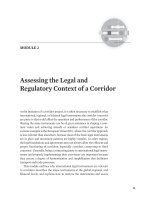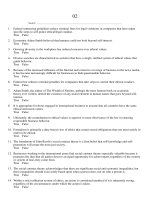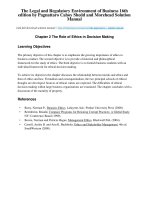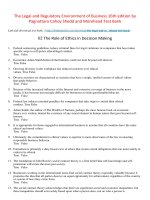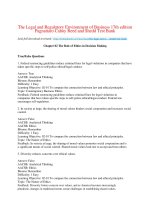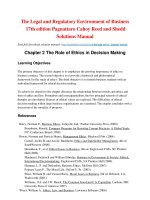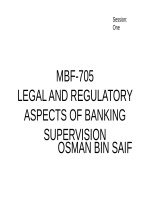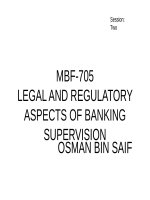Lecture Legal and regulatory aspects of banking supervision – Chapter 4
Bạn đang xem bản rút gọn của tài liệu. Xem và tải ngay bản đầy đủ của tài liệu tại đây (275.82 KB, 35 trang )
Session:
Four
MBF-705
LEGAL AND REGULATORY
ASPECTS OF BANKING
SUPERVISION
OSMAN BIN SAIF
Summary of Previous Session
•
–
Credit rating agencies
–
Mortgage Brokers
–
Secondary Mortgage Markets
The Mess
–
Evolution of Home Mortgage
–
New model of Mortgage lending
–
Private sub prime mortgage process
–
Reasons for forming of subprime mess
2
Agenda of this session
•
Big Assumption
•
Misaligned incentives & pitfalls
•
Good Days turn Bad
•
Start of Failure
•
Sub prime Global financial crisis
•
Financial Crisis
–
Poor investors
–
Desperate Bank
3
Agenda of this Session
•
Finance and Economy
•
Investment devalued across the Globe
•
Impact of Financial crisis across the Globe
4
Big assumptions
•
Belief that modern capital markets had become
so much more advanced than their
predecessors that banks would always be able
to trade debt securities. This encouraged banks
to keep lowering lending standards, since they
assumed they could sell the risk on.
5
Big Assumptions (Contd.)
•
Many investors assumed that the credit
rating agencies offered an easy and
cost-effective compass with which to
navigate this ever more complex world.
Thus many continued to purchase
complex securities throughout the first half
of 2007 – even though most investors
barely understood these products.
6
Big Assumptions (Contd.)
•
Most crucially, there was a widespread
assumption that the process of “slicing
and dicing” debt had made the
financial system more stable.
Policymakers thought that because the
pain of any potential credit defaults was
spread among millions of investors, rather
than concentrated in particular banks, it
7
would be much easier for the system to
Misaligned incentives & pitfalls
•
•
“churning” of capital “allows even an institution
without a great amount of fixed capital to make a
huge amount of loans, lending in a year much
more money than it has
If an individual or class of victims obtains a large
judgment, the lender’s management can simply
declare bankruptcy, liquidate whatever limited
assets are left, and possibly reform a new
company a short time later.
8
Misaligned incentives & pitfalls
(Contd.)
•
Securitization conduit divides various
lending tasks into multiple corporate
entities—a broker, an originator, a
servicer, a document custodian, etc.—the
conduit tends to prevent the accumulation
of a large enough pool of at risk assets to
attract the attention of class action
attorneys, which tend to be the only actors
capable of obtaining system-impacting
judgments.
9
Good days turn bad. Crisis at the door (mid 2006
onwards):
•
•
•
Through financial innovations loans issued
to borrowers at minimal rate, adjusted rate.
By mid 2006 time to pay bigger amounts
comes
Household income did not increase in same
proportion as house prices
Subprime mortgage owners start defaulting
10
Good days turn bad. Crisis at
the door (mid 2006 onwards):
•
•
•
•
•
Rating agencies revise ratings of
MBS/CDO as expected number of defaults
turn out higher. Many ratings are lowered
Bewildered investors lost faith in ratings,
many stop buying MBS/CDO altogether
Alarm bell at SIV/SPVs
Banks find themselves in non-comfortable
position , stop making loans
11
what a mess….
•
•
More frenzy in market and more defaults, again
revised ratings, again further stoppage of funding
and further stoppage of loans, further fall in house
prices as demand and supply
mismatch....problem feeding itself in circular
fashion.
As MBS/CDO market is shaken….investors start
debating other derivatives true worth…panic
spreads across and people start getting
out….further hurting the banks
12
What a mess
•
•
The crisis unfolded as silent Tsunami on
Wall Street where by the time people
realized the graveness of the mess they
were in , it had gone beyond control.
Since, most of the player in the market,
mortgage brokers, investment banks were
running in debts. They are suddenly
caught unaware and are in insolvency and
start tumbling down….many are saved by
nationalization as their fall would13spread
What a mess
•
Central government start pumping in
money as last resort but one thing is
surely not returning soon and which is
very vital in financial industry -FAITH.
14
In Short
•
•
•
When homeowners default, the amount of cash
flowing into MBS declines and becomes
uncertain.
Investors and businesses holding MBS have
been significantly affected.
The effect is magnified by the high debt levels
maintained by individuals and corporations,
sometimes called financial leverage.
15
Those good old days were gone
now!!
16
How Subprime became Global
Financial Crisis?
How could problems with subprime mortgages, being
such a small sector of global financial markets,
provoke such dislocation?
•
•
Lets look into it from start again:
Industry data suggest that between 2000 and 2006,
nominal global issuance of credit instruments(MBS/CDO)
rose twelvefold, to $3,000bn a year from $250bn
17
How Subprime became Global
Financial Crisis? (Contd.)
•
•
Became intense from 2004, partly
because investors were searching for
ways to boost returns after a long period in
which central banks had kept interest
rates low.
“slicing and dicing” was fuelling a credit
bubble, leading to artificially low borrowing
costs, spiraling leverage and a collapse in
lending standards
18
How Subprime became Global
Financial Crisis? (Contd.)
12
10
In billion US $
8
6
4
2
0
19
Build up into a financial crisis…
•
•
•
•
In 2003, Bank of International Settlements(BIS)
repeatedly warned that risk dispersion might not always
be benign. But US Federal Reserve was convinced that
financial innovation had changed the system in a
fundamentally beneficial way.
No efforts made to correct debt to equity ratios of bank
Huge trust in the intellectual capital of Wall Street –
supported by the fact that banks were making big money.
When high rates of subprime default emerged in late
2006, market players assumed that the system would
absorb the pain.
20
Build up into a financial crisis
(Contd.)
•
•
•
Initial estimate of subprime loss put to
$50bn-$100bn by US FED
Subprime losses started to hit the financial
system in the early summer of 2007 in
unexpected ways. As the surprise spread,
the pillars of faith that had supported the
credit boom started to crumble.
Investors woke up to the fact that it was
dangerous to use the ratings agencies as
21
a guide for complex debt securities.
Poor Investors….
•
•
–
Shocked investors (sitting in all parts of the world) lost faith
in ratings, many stopped buying complex instruments
altogether
That created an immediate funding crisis at many
investment vehicles ( remember SIV), since most had
funded themselves by issuing notes in the asset-backed
commercial paper market.
Many banks had not yet passed on the risk to others.
Many were holding asset-backed securities in
“warehouses” and were working on splicing them up into
CDOs, getting them rated by a credit agency such as
Moody’s or Standard & Poor’s. Several banks were caught
out not only because it took time to structure22the securities
Poor Investors (Contd.)
•
•
•
It also meant that banks were no longer
able to turn assets such as mortgages into
subprime bonds and sell these on.
That in turn meant the key assumption
that the capital markets would always stay
liquid – was overturned.
Assumption that banks would be better
protected from a crisis because of risk
dispersion – also cracked.
23
Desperate banks….
•
•
•
As a result, western banks found themselves
running out of capital
Banks started hoarding cash and stopped
lending to each other as financiers lost faith in
their ability to judge the health of other
institutions – or even their own.
The London interbank offered rate(LIBOR), the
main measure of interbank lending rates, rose
sharply
24
Desperate Bank (Contd.)
•
•
•
Firms became reluctant to participate in
money markets ... as a result subprime
credit problems turned into a systemic
liquidity crunch.
Vicious deleveraging spiral got under way.
As banks scurried to improve their balance
sheets, they began selling assets and
cutting loans to hedge funds.
But that hit asset prices, hurting those
25
balance sheets once again.
